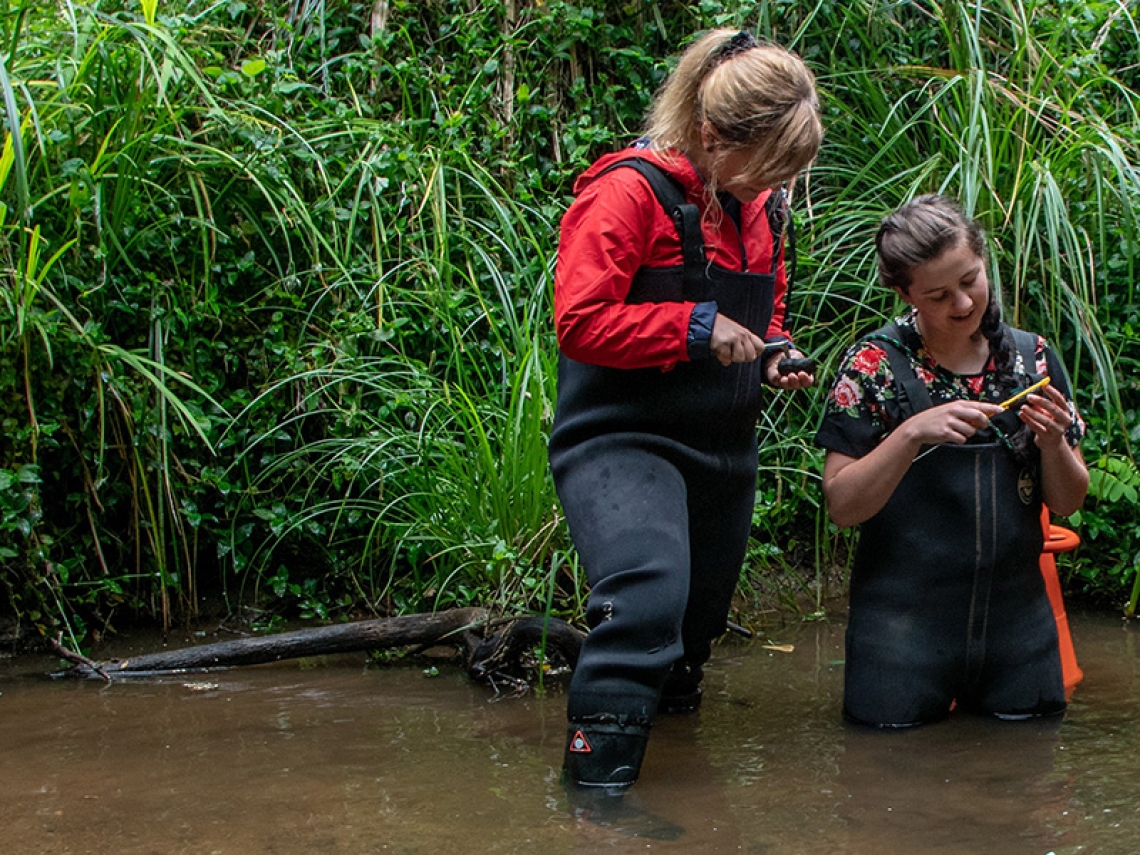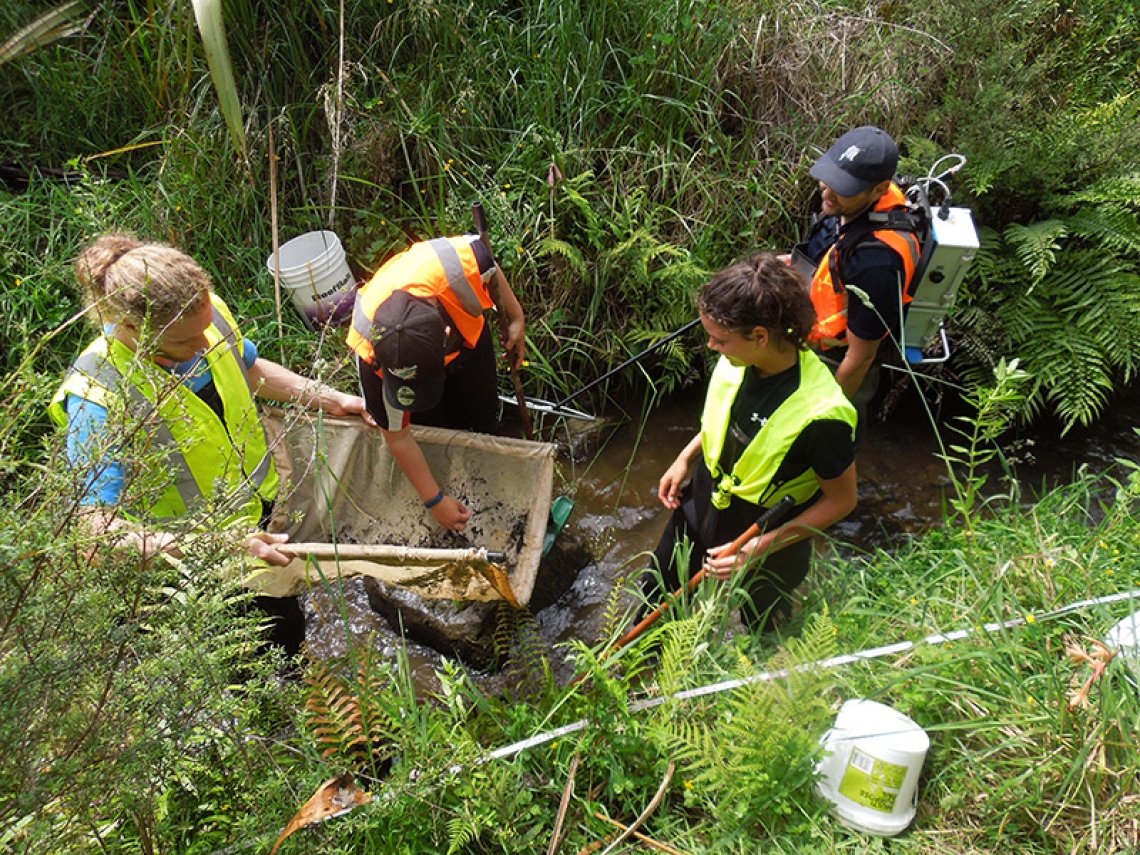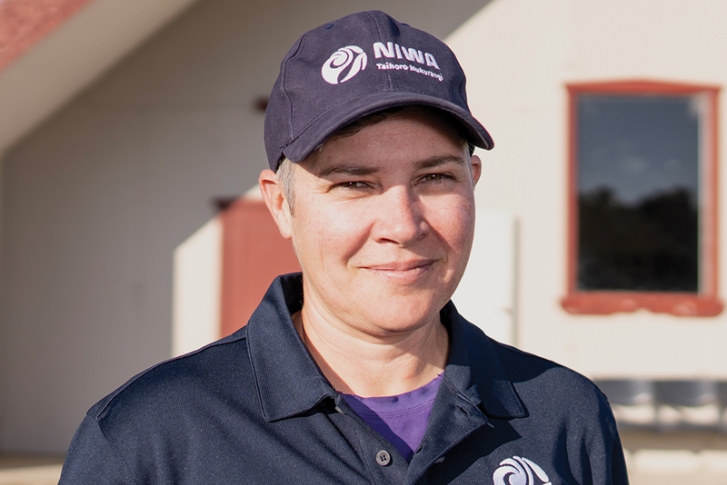In collaboration with the University of Waikato, the CKS team has also supported five graduate students and three summer research scholarship interns through a variety of practical experiences. These experiences include developing strong professional networks and understanding of the importance of partnerships between hapū/iwi, agencies, and research providers.
Michele Melchior: The complex reproduction strategies of E. aucklandica
CKS PhD student Michele Melchior has shown that E. aucklandica has a specialised mode of reproduction that strongly differentiates it from E. menziesii.
All kākahi were thought to reproduce by releasing clouds of larvae into a waterway. The larvae attach themselves to passing fish and hitchhike upstream to a new habitat where they fall off, settle and grow. They transform from a larva into a juvenile mussel during this parasitic hitchhiking phase. But Michele Melchior has discovered that is not the case for the larger Echyridella aucklandica species.
Mostly found in the Waikato northwards but dying out faster than their counterparts, this species releases their larvae in enticing packages called conglutinates, like fly-fishing lures to attract certain fish species. The lures are between 5 and 9 mm long, look like a small flatworm, and carry on their back about 200 tiny larvae, each about the size of a grain of sand. Fish that are attracted to the lures try to eat them, giving the larvae, shaped like pac-men, a chance to attach to the gill. Once on the fish they can then transform into juveniles. The next stage of the research is to understand which fish are most attracted to the lures.
Understanding the reproductive biology of E. aucklandica will help to tailor restoration techniques for this species – for example, by improving habitat for the host fish species that enable E. aucklandica to complete its life cycle, and by developing in vitro culture methods to produce juveniles in the laboratory.
Nicole Hanrahan: Interactions between host fish and kākahi
In the kākahi life cycle, larvae (glochidia) are parasitic and attach to a host fish where they grow and transform into juveniles. The juvenile kākahi then detach from the host fish, sink to the bottom of the stream and then burrow into the sandy sediment where they grow out. CKS MSc student Nicole Hanrahan investigated the relationship between larval kākahi (E. menziee) and native fish in Waikato streams. Her key research questions were 1) do host fish develop an immunity to kākahi larvae and 2) what are the different host fish that kākahi larvae attach to. Nicole found during field and lab trials that most of the kākahi larvae were attached to common bully or more broadly their species Gobiomorphus spp. She also found that Gobiomorphus spp do not develop an immunity after hosting kākahi several times. This is important because we now know that common bullies are important hosts for the kākahi larvae and must be protected in any future restoration efforts.
During her field trials Nicole also developed a method to inspect fish for glochidial infestation that has been added to our toolbox of kākahi monitoring techniques.
Riki Parata: Understanding in-stream and stream edge habitat suitability for koura
Kōura populations have been impacted by habitat loss and water quality degradation. As Kōura are nocturnal and generally seek refuge during the day it is important to understand what habitat kōura are using during the day to better increase the survival rates of the juvenile kōura.
Riki Parata’s Master of Science research focused on the micro-habitat used by juvenile koura. His research looked at two key questions:
- What habitat do kōura prefer
- Can man-made habitats be used to increase the survival of juvenile koura.
Riki surveyed 12 Waikato sites with different types of riparian land use (i.e., planted, vs pasture, vs native forest). He found that kōura like living in ponga logs, root systems, and large leaf litter during the day.
Riki also constructed two types of artificial instream habitats; 1) coconut fibre matting (to simulate ponga root systems) and 2) ponga frond bundles (to simulate natural habitats found in native forest) and found that there is benefit in adding artificial habitat (particularly in pastoral streams poor in organic matter) during periods when juvenile kōura are particularly vulnerable to predation (after release from the brooding female) and during high flow events.
You can read Riki Parata’s Master of Science thesis at https://researchcommons.waikato.ac.nz/handle/10289/13086
Johlene Kelly: Influence of riparian plantin
Riparian fencing and planting are key management tools used in New Zealand to mitigate the effect of land use in streams. CKS master’s student Jolene Kelly’s research focused on the effect that riparian vegetation has on kōura populations. Johlene surveyed 26 sites across 16 Waikato Streams, examining the role of different aged riparian plantings in the provision of habitat for kōura, compared to a wide range of other factors (e.g., catchment size, geology and predation). Johlene found that that upper catchment size and geology had the most influence on instream habitat for koura rather than the riparian margins. However, riparian fencing and planting can be a useful tool to protect and restore kōura populations. Restoring riparian margins can:
- provide more tree roots in the stream for kōura to hide and protect themselves from predators
- restrict aquatic plant growth due to more shading over the stream. Kōura are more easily preyed upon when there is a lot of aquatic plant growth.
These findings are being used to inform the prioritisation of sites for restoration in the Ngāti Tahu-Ngāti Whaoa (NTNW) rohe, through the combination of NTNW mātauranga and other knowledge sources.
You can read Johlene Kelly’s full Master of Science thesis at https://researchcommons.waikato.ac.nz/handle/10289/12934




